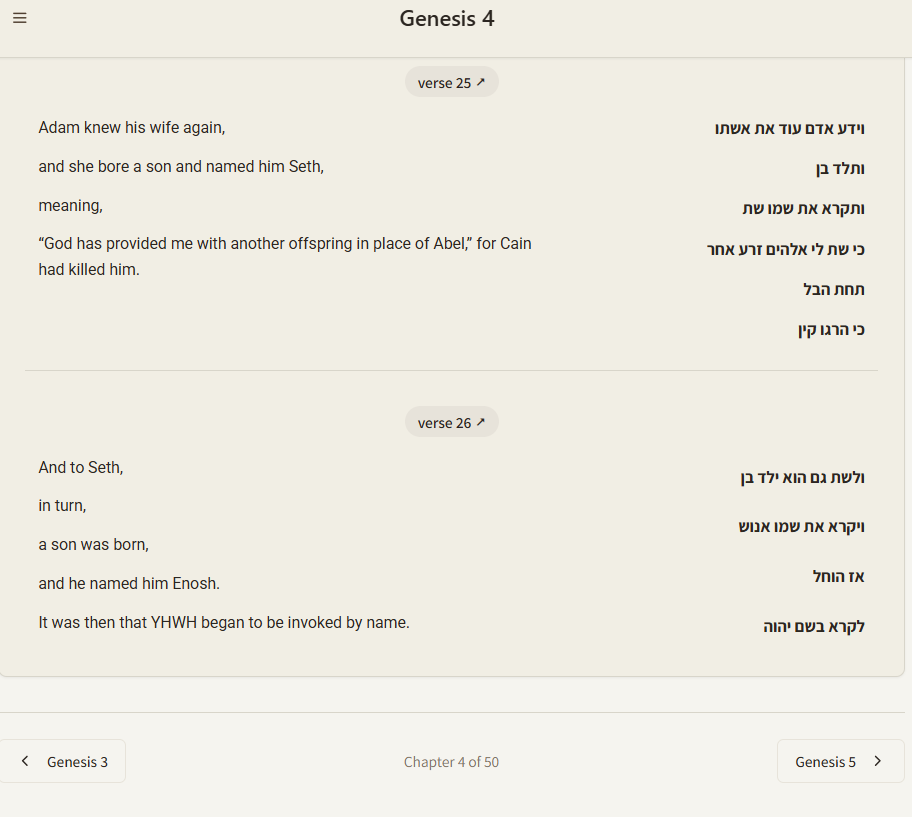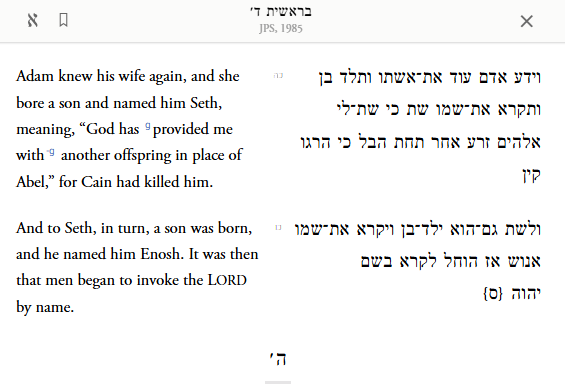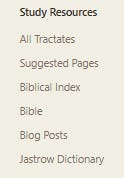Introducing the ChavrutAI Bible Reader
I developed the ChavrutAI Bible Reader as a natural extension of the existing Talmud study platform. While ChavrutAI has served users studying the Babylonian Talmud with parallel Hebrew-English text, the platform lacked direct access to the biblical texts that the Talmud frequently cites and analyzes. This new reader fills that gap by providing the complete Hebrew Bible (Tanach) with JPS 1985 English translation in the same interface.
The reader includes all 39 books of the Hebrew Bible—from Genesis through II Chronicles—organized according to the traditional Jewish ordering of Torah, Nevi’im (Prophets), and Ketuvim (Writings). Each of the 929 biblical chapters is accessible through a clean, hierarchical navigation system that mirrors the existing Talmud interface.
As with Talmud, a major “value-add” over Sefaria is the text processing: clauses are split into new lines, making the text more accessible and easier to analyze. As well as many other “opinionated” features, to provide an alternative reading/study experience.1
Outline
Design Philosophy
Navigation Structure
Text Processing and Display
Integration with Existing Platform
Content Source and Attribution
Technical Implementation and Future Development
Appendix - Technical
Text Processing Pipeline
Design Philosophy
The Bible reader maintains visual and functional consistency with ChavrutAI’s Talmud interface while accommodating the unique characteristics of biblical text. Unlike Talmudic passages, biblical chapters are traditionally split by discrete verses with clear numerical markers.2
As for the Talmud, Hebrew text appears in a bold, right-to-left display with user-selectable fonts including Noto Sans Hebrew, Frank Ruhl Libre, and David Libre. The English translation sits alongside the Hebrew, allowing readers to move between languages naturally. Text size controls accommodate different reading preferences and vision needs, with five size options ranging from extra-small to extra-large.
The interface preserves the sepia-toned aesthetic that characterizes the rest of ChavrutAI, creating visual continuity for users moving between Talmudic and biblical texts. This consistency extends to navigation patterns, with the same hamburger menu and breadcrumb system available throughout the platform.
Navigation Structure
The Table of Contents implements the traditional three-tier navigation hierarchy. The top level presents all 39 books organized by section: Torah (5 books), Nevi’im, and Ketuvim (Writings, 13 books). Each section displays books in their traditional order with Hebrew and English names.
Selecting a book brings up a chapter overview page. For example, Genesis displays 50 numbered chapter buttons in a grid layout:
https://chavrutai.com/bible/genesis:
These overview pages include basic metadata: the book’s Hebrew name and total chapter count.
Compare with Sefaria:
https://www.sefaria.org/Genesis:
Individual chapter pages present the actual biblical text. Each verse appears as a discrete unit with its own number and formatting. The chapter page includes previous/next navigation buttons to move sequentially through a book, and every verse links directly to its corresponding page and section on Sefaria for users who want additional commentary or alternate translations.
For example, screenshot of the final verses of Genesis 4:
https://chavrutai.com/bible/genesis/4:
Compare this with Sefaria’s view:
Text Processing and Display
The biblical text required different processing strategies than Talmudic text. I implemented cantillation-based segmentation for Hebrew verses, splitting text at three specific cantillation marks: Etnahta, Zaqef Qatan, and Revia. These marks typically correspond to syntactic boundaries. After segmentation, the display removes all cantillation marks and nikud (vowel points) to present clean, unpointed Hebrew text.3
English verses undergo punctuation-based segmentation, splitting at commas, semicolons, colons, periods, and em-dashes. This creates parallel segments that roughly align with the Hebrew divisions, though perfect one-to-one correspondence isn’t feasible (due to the programmatic nature of the splitting, as with Talmud).
The reader handles several biblical text conventions automatically. Ketiv-Qere notations—where the written form (ketiv) differs from the traditional reading (qere)—appear in parentheses without special styling, since these represent textual rather than interpretive notes. The divine name (Tetragrammaton) is consistently converted to ‘YHWH’ (as it is for Talmud, when citing verses).
Integration with Existing Platform
The Bible reader integrates into ChavrutAI’s existing infrastructure. Navigation appears in the main footer under “Study Resources,” positioned between the Bible-Talmud Index and Blog Posts links:
The HTML sitemap includes a “Bible Reader” entry, and I generated a dedicated XML sitemap (sitemap-bible.xml) containing all 969 Bible-related URLs for search engine indexing.
The reader respects all existing user preferences for text size, Hebrew font selection, and theme settings, maintaining a unified experience across the platform.
Content Source and Attribution
All biblical text comes from Sefaria.org through their public API. Hebrew text uses Sefaria’s default Masoretic text (Miqra according to the Masorah), while the English translation uses the 1985 Jewish Publication Society Tanakh. I chose the JPS 1985 translation (from the other translations available on Sefaria) for its scholarly rigor, contemporary English, and widespread acceptance in academic and religious study contexts.
The reader makes two API calls per chapter—one for Hebrew text and one for English—due to limitations in Sefaria’s API v3 architecture. Each chapter page prominently attributes the text source with “Powered by Sefaria” branding and individual verse links back to Sefaria’s website, ensuring proper credit for their invaluable public resource.
Technical Implementation and Future Development
The reader functions as a full-stack web application built on the same React/Express foundation as the rest of ChavrutAI. Development included data structure design, API integration, text processing logic, frontend components, and comprehensive testing across all 39 biblical books.
The system currently supports read-only access to biblical texts. Future enhancements might include highlighting for personal names, place names, and thematic concepts similar to the term highlighting available in Talmud pages. Cross-referencing between Talmudic passages and their biblical sources represents another potential development direction, though this would require substantial indexing work.
The reader’s addition brings ChavrutAI closer to being a broader Jewish text platform. Students can now move between primary biblical texts and their Talmudic interpretations without switching applications or losing their preferred reading settings. This integration serves the fundamental goal of making classical Jewish texts more accessible to contemporary learners.
Appendix - Technical
Text Processing Pipeline
Hebrew Processing (server/lib/bible-text-processing.ts):
HTML Stripping: Remove Sefaria’s HTML markup, footnotes, and special annotations
Cantillation-Based Segmentation: Split verses at Etnahta (U+0591), Zaqef Qatan (U+0594), and Revia (U+0597) marks, extending to word boundaries
Nikud Removal: Strip all cantillation marks (U+0591–U+05AF) and nikud (U+05B0–U+05C7)
Special Character Handling: Replace maqaf (־) with space, remove paragraph markers
({פ}, {ס}), normalize whitespaceKetiv-Qere Preservation: Maintain parenthetical notations without style modification
English Processing:
HTML Stripping: Remove footnote markers and HTML tags
Divine Name Normalization: Replace “the LORD”, “GOD”, “ETERNAL” with consistent rendering - ‘YHWH’
Punctuation-Based Segmentation: Split at commas, semicolons, colons, periods, question marks, exclamation points, and em-dashes
Quote Handling: Preserve closing quotation marks with sentence-ending punctuation
Whitespace Normalization: Clean up spacing while preserving intentional line breaks
On these opinionated design choices, compare my related “ChavrutAI: A New Way to Study Talmud” (Sep 10, 2025). Much of what I discuss there, applies here as well, mutatis mutandis.
The code for this feature is available at the Github repo, as for the rest of the app.
As an aside, I also recently fixed a number of small bugs related to text processing (described in the changelog), as well as improved the UI of the footer.
I plan to discuss this in more detail in a future post, discussing the history of it; for now, see Wikipedia, “Chapters and verses of the Bible”.
For my perspective on nikud, see my previous piece.






